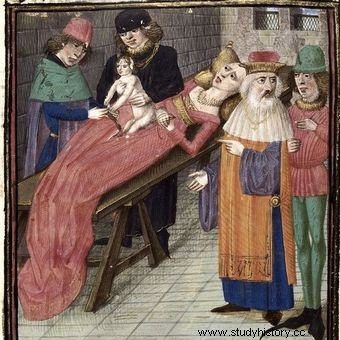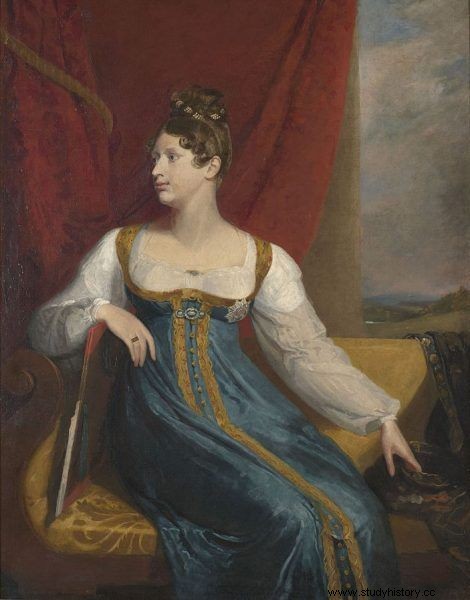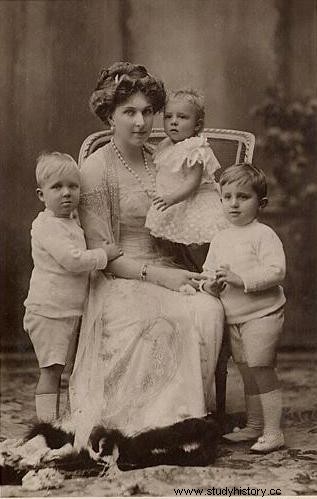Monarchs and princesses were deprived of privacy during one of the most intimate activities - giving birth to their child. The birth of an heir or heiress was a matter of state importance, therefore the risk of replacing the newborn had to be eliminated.
To this end, crowds gathered in the birthing rooms:courtiers, representatives of the aristocracy, politicians. The lack of privacy did not help the woman in labor, who was stressed enough from the pain and sense of responsibility for the continuity of the dynasty. It seems that the worst treatment was experienced by the French queens in the 17th and 18th centuries ...
France
Queen Maria Teresa, the Spanish wife of Louis XIV, was to give birth in early November 1661. The woman spent the last weeks of her pregnancy in her own rooms, resting and preparing for the big event. Everything changed when on November 1, 1661, the monarch began to give birth. Then the room where the childbirth was to take place was filled by several dozen courtiers:princesses, princes, officials.
The news of the upcoming event spread all over Paris, and a cheering crowd gathered in front of the palace windows. "Spanish actors danced and musicians played harps, guitars and castanets to remind Maria Theresa of her native country," writes Antonia Fraser, Louis XIV's biographer. in spirit. The effect achieved, however, was the opposite, because the woman began to whisper:I do not want to give birth, I want to die. "
After 12 hours of childbirth, the queen gave birth to a son. Louis XIV opened the window and shouted to the subjects outside, "The Queen gave birth to a boy!".

After the woman gave birth to her daughter after 12 hours of hardship, her bedroom was completely filled with people and the queen passed out. It was only after a few minutes that Marie Antoinette was noticed unconscious and the window was opened.
The first birth of Marie Antoinette had an equally shocking course. On December 19, 1778, in the morning hours, the monarch took a special bell to signal the beginning of childbirth . Then crowds of courtiers marched towards the queen's bedroom.
Most of them were located in adjacent rooms, but a few people managed to get into Marie Antoinette's room and watched the course of the event. After the woman gave birth to her daughter after 12 hours of hardship, her bedroom was completely filled with people and the queen passed out. It was only after a few minutes that Marie Antoinette was noticed unconscious and the window was opened.
England
Public births became compulsory in the British royal family in 1688. Then there was the birth of Queen Maria Beatrice, wife of Jakub II, née Princess Modena. Although 42 officials watched the arrival of the couple's son into the world, rumors began circulating in London that the child had been replaced. Ministers denied the revelations, but rumors grew louder. They were of interest to Maria Beatrice's opponents, who could not accept the fact that their queen professed Catholicism. This discontent gradually led to the overthrow of James II.
Privy Council members attended the birth of Charlotte, 21, Princess of Wales in 1817. The doctor informed the officials about the departure of the waters by sending them short notes. The ministers gathered in the library adjacent to the duchess's room, and the doctor kept them informed about the course of the delivery. Unfortunately, Charlotte's son was born dead, and a few days later, as a result of postpartum complications, the Princess of Wales also died.

Princess Charlotte Augusta of Wales
When Queen Victoria's descendants were born, by her side were a midwife, a doctor, and her beloved husband, Albert, who massaged her feet, wiped sweat from her forehead, and held her hand. The monarch, however, could not enjoy privacy because the door to her room was wide open and officials in the next room could follow the course of the delivery.
In 1894, Victoria issued a decree requiring only one minister to be present and only on the birthday of the heir or heir to the throne.
Spain
In 1906, 19-year-old Princess Victoria Eugenia - called Ena-Battenberg, granddaughter of Queen Victoria, married King Alfonso XIII of Spain. And it found its way to one of the most conservative courts in Europe, which still operated according to medieval traditions. One of them concerned the birth of royal descendants. Right before the dissolution, the relics of saints sent from all corners of Spain were placed in the room of the young monarch.
At the local court, the presence at the royal childbirth was considered a great honor, therefore not only ministers, but even diplomats accredited in Madrid were invited. When Ena felt its first contractions on May 10, 1907, the royal halberdiers went to Spanish and foreign officials for an invitation to the royal palace. Soon, approx. 150 men gathered in the rooms adjacent to the mother's room:clergymen, diplomats, ministers, courtiers .
According to the etiquette of the time, they were dressed in gala uniforms (both military and civilian). Those holding the highest positions found themselves right at the door to Ena's room and had to listen to the screams of the woman. People of lower rank ended up in adjoining rooms. Over a thousand people gathered in front of the palace. Madrid residents.

Ena, Queen of Spain and children. Photo:Christian Franzen (Madrid) circa 1911
The head of the Spanish government, Antonio Maura, was present at all times with Victoria Eugenie. It was the prime minister who announced to the officials that a boy was born:"Gentlemen, this is a prince." In response, he heard:"Long live the queen! Long live the king! Long live the prince! ”.
After a dozen or so minutes, the happy father Alfonso XIII emerged from the birthing room and presented his firstborn son to the audience, who was lying in a gilded cradle placed on a large silver tray.
Bibliography:
- Fraser A. Love and Louis XIV. The Women in the Life of the Sun King. New York, 2006
- Fraser A. Marie Antoinette:the Journey. New York, 2002
- GelardiJ., Born to Rule. Granddaughters from Victoria. Queens of Europe. London, 2005
- Packard J. M. Victoria's Daughters. New York, 1998
